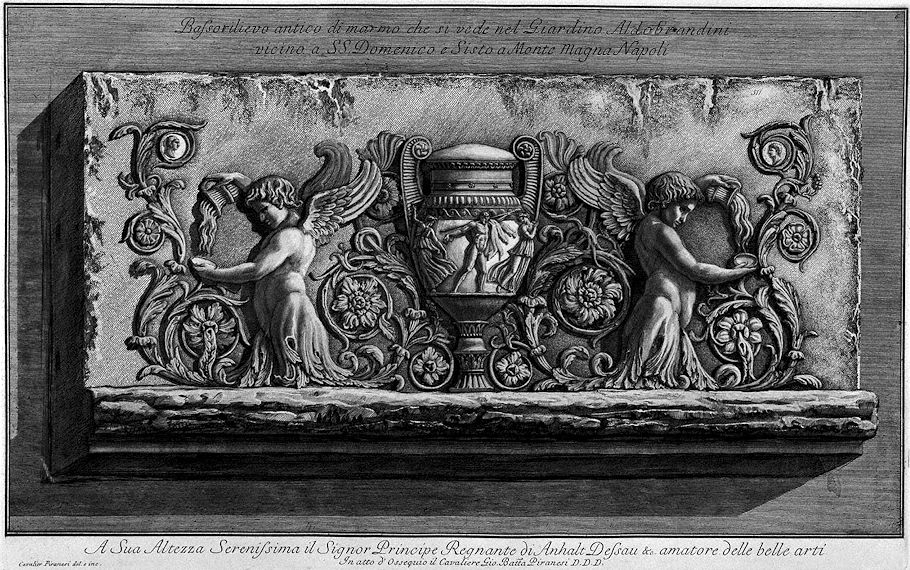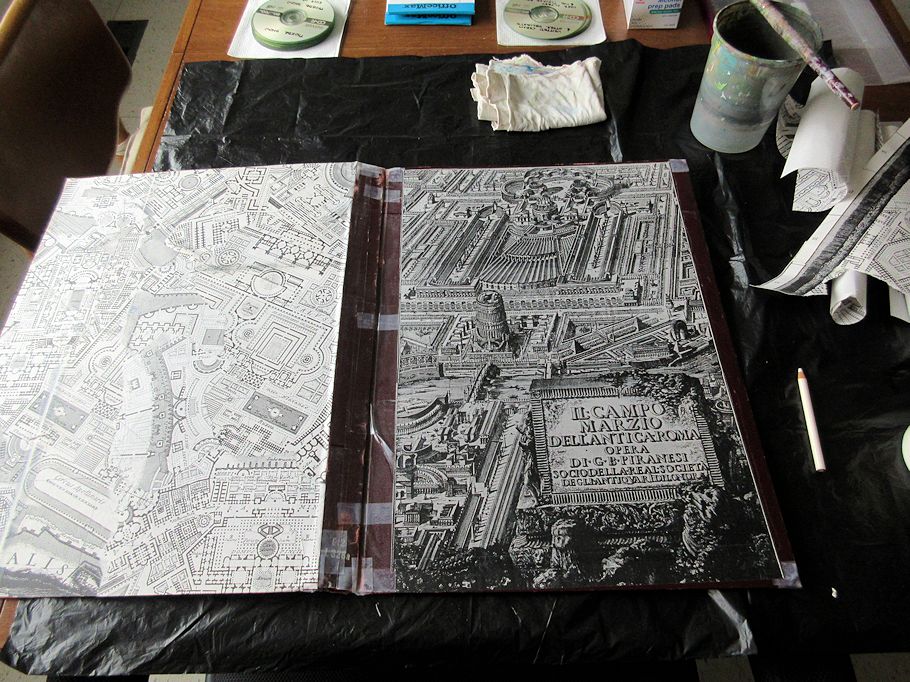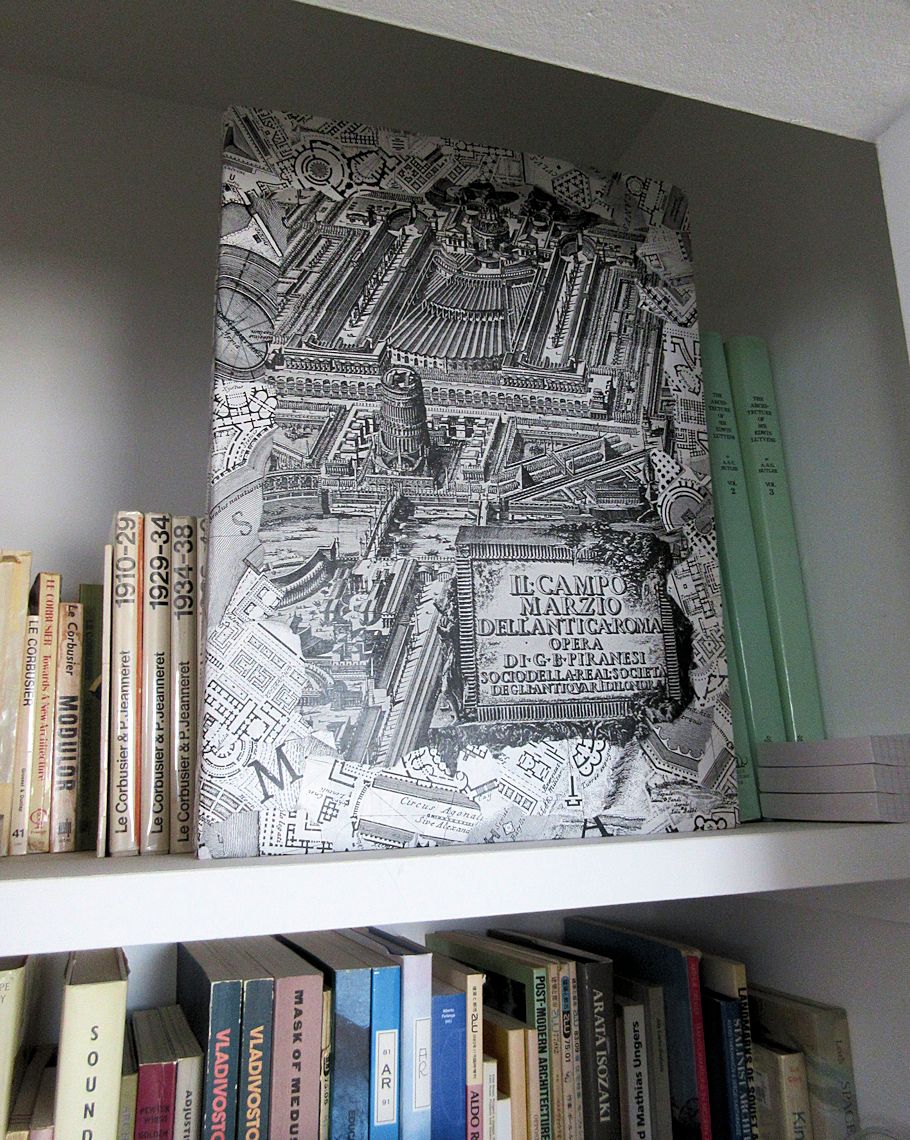15 January 1778 Thursday
Vases, Candelabra, Grave Stones, Sarcophagi. Tripods, Lamps and Ancient Ornaments volume I

Ancient marble bas-relief that can be seen in the Aldobrandini garden in Magnanapoli.
To His Serene Highness the Regnant Prince of Anhalt Dessau &c lover of the fine arts
In deed of respect the Knight Gio. Batt(ist)a Piranesi D. D. D.
Cav. Piranesi F.
15 January 1812 Wednesday

Morning clear, wind I believe came round in the night by E & S to SW. Spent forenoon in looking over my Bills & making out some Checks. At noon was at my Brothers & had some money deposited in B.P. & B.N.A. Dined by invitation at J.L. Fisher’s, where were my daughter M.G. Fisher, S & SL, & T. Gilpin; in the evening I paid some visits, returned to Mulberry Street which I believe I may now call my home when in the city. I lodged there comfortably. Snow in the night.
15 January 1997
new insights - material from Sue Dixon
After going through the material sent by Sue Dixon, I found some new insights concerning my interpretations of the Campo Marzio. Through Sue's glossary of Latin words I now know the program of the Bustum Hadriani (and likewise the Bustum Augusti) which is essentially one enormous "death machine"--it is an entire complex devoted to the logistics of passing from this life to the next. (Just now I thought of Rossi's original plan for the cemetery of Modena.) There are crematoriums and banquet halls and a stage (for viewing perhaps?), tombs galore for family and slaves--like one gigantic funeral home on an Imperial scale.
Of course, this reinforces my idea of the Bustum Hadriani as an axis of death which is 90 degrees perpendicular to what I believe is the axis of life. That Piranesi put such a large emphasis on death is not at all inappropriate, however, given the fact that the dead of Rome were buried outside the (old?) walls, i.e. most often/primarily in the Campo Marzio.
triumphal way - new ideas
I also have new ideas concerning the "triumphal way." I now see that it starts at the temple and altar of Janus, and this is significant because of Janus' connection with Rome and war. Furthermore, the notion of Janus as beginning/ending is also significant, and the "way" beginning (and conversely ending) at Janus is complimented be the way ending (and conversely beginning) a the alter/temple of Mars.
As the route proceeds from the Janus sector, it makes its way through the Campo Marzio's "theater district"--in every way a "downtown," commercial/entertainment zone complete with shops, small baths, and brothels. I am very much reminded of New York's Time's Square and Broadway in its great mix of accommodation and "entertainment." The fact that the Triumphal Way weaves through this type of urban area makes Piranesi's plan/program of the Campo Marzio not at all unlike any major metropolis today. (I now have so much more to say about the "way.")
As the "way" proceeds further, it crosses the Tiber and into an area that is almost the antithesis of the "theater district," i.e., the Bustum Hadriani--one huge cemetery. Going from one extreme to another gives the "way" a potent symbolic nature, and I can elaborate on this in how even though the plan of the Campo Marzio is all drawn in the same manner, the actual character of the various sectors of the Campo Marzio are very varied and distinct, and the "way" symbolically calls out (calls precise attention to) the extreme cases.
I now have more of a case in making note of the extreme suburbs, as well.
15 January 1998
places of Nero
Throughout this chapter I will call out the "presence" and significance of Nero. From the towers within his gardens (Piranesi's reference to Nero's watching the great fire of AD 60?) to the other Nero landmarks throughout the Ichnographia. Citing Suetonius as to the placing of Nero's ashes within the area of the Ichnographia's Bustum Augusti.
...read Tacitus' Annals as well. The ancient authors offer a wonderful resource with regard to who built what, and what existed when, and even who knocked down what.
15 January 2000
pretty [scary] hybrid?
The following is an anecdote relative to the (new) notion of beauty (and aesthetics), etc.:
While still an architecture student, I spent the summer of 1978 working for the Historic American Building Survey (HABS) stationed in Perry, Missouri, a very small town (pop. 931) 30 miles west of Hannibal (of Mark Twain fame). It was then that the city of St. Louis (120 miles south) became the 'big city' destination on several weekends. What struck me the most in St. Louis was Eero Saarinen's Gateway Arch--not only is it an incredible site from a distance, but even more amazing when perceived while walking around its base, (and I won't elaborate here about the "otherness" of its elevator ride up to the top observation room inside, which I believe I heard is something you can't do anymore).
On what was my third visit to St. Louis, I was with several of the other student architects I lived and worked with--it was their first trip. We were all around the same age and education level, i.e., early twenties and full of youthful over-confidence. I distinctly remember being asked by Mike, "So, what do you think of the arch?" (Mike and I were room mates, and we often 'discussed' architecture). I said, "I think the arch is very pretty." Well, Mike quickly told me that one just DOES NOT use the word 'pretty' when referring to architecture!--(apparently) pretty has such lowly connotations. I briefly argued that I thought 'pretty' was the best word to describe how I saw the arch, largely because I see its 'prettiness' as pretty much undeniable. I was confident I used the right word to describe how I felt about the arch.
Today, just two weeks into the 21st century, I looked up pretty in Webster's Third International Dictionary:
pretty 1 a : marked by or calling for skillful dexterity or artful care and ingenuity, esp. in coping with some difficult or complicated matter.
I am thus (finally) completely convinced I saw the arch for what it is, and then also described how I saw the arch in a most fitting manner.
Now being somewhat older (and hopefully somewhat wiser), if I were today asked what I thought of the arch, I'd say, "The St. Louis Arch is very likely the prettiest architecture-sculpture hybrid I will have ever perceived."
15 January 2001
Really Good Architecture
One of the new architectures that exists today, and, moreover, an architecture not designed by an architect and not even buildings, are those 'places' in cyberspace that do much more than actual buildings of their type could ever do. I'm referring particularly to amazon.com and ebay.com as architectures that far surpass what a physical book store or auction house can do. These are new architectures not in that they replace the existing architectural paradigms, rather they provide whole new means of buying and auctioning that a physical building could never provide.
I believe that if an architect today says that places in cyberspace can never be considered architecture, all he or she is really doing is manifesting a huge denial, and, moreover, just one more denial added to the continual history of things that architect's have tried to deny.
I use amazon and eBay frequently. I have both bought and sold items (mostly books, even rare volumes). In fact, just this morning the postman delivered a Piranesi print, a print which I successfully bid on last weekend at eBay. It was the architecture of eBay that brought me Piranesi's engraving of ancient Rome's last Imperial artifact. I was confident in bidding on the print online via a written description and two digital images because of the Piranesi research that I have done and continue to do at home, online, and at university libraries. [By the way, Piranesi is a great proto-virtual-place architect.] This print of the sarcophagus of Maria, wife of the Emperor Honorius, was originally published within Piranesi's Il Campo Marzio (1762), specifically at the head of the dedicatory letter to Robert Adam. In true inversionary fashion, Piranesi cleverly placed an image of ancient Rome's last Imperial artifact at the beginning of the Il Campo Marzio publication. This print is the latest acquisition of Quondam - A Virtual Museum of Architecture.
Architecture is a medium, a facilitator, and a container, and all reality is relative to the vastness of its container.
denial
The point is that today not all architectures are buildings. This is not to deny the real world, rather to recognize the notion that architecture, by architects, now has further options of being designed without the usual physical means.
I repeat, the new architecture of cyberspace does not replace real world architecture. If the implication is not clear, I then add that the new architecture of cyberspace does not deny real world architecture either.
In the several times I have brought up this issue within various venues, there is always the counter argument of an "either-or" attitude. Is it really that difficult to grasp that cyberspace offers a new, addition realm within which architects can design places? I use the notion of 'place' because the notion of a virtual building is only one type of cyber place.
I can well remember back in 1983 when I first learned and professionally utilized CAD, specifically the many, many professional colleagues (both in offices and academics) that saw no place within the field of architecture for computers and cad. That's the type of denial I was referring to.
15 January 2013
The quest for Architectural Theory
Hint (of recent architectural theory/practice): less (homogeneity) is more (diversity).
15 January 2014
15 January
...Tafuri teaches nonlinear history, its irreducibility into overly simplistic explanations--in whose name the universe of architectural discourse pretends to provide a presumed disciplinary autonomy; he teaches "knowing through signs and conjectures . . . not bases and certitudes." He teaches the intrinsic contradictoriness of history, or rather, the coexistence of a multiplicity of tensions within it; but he also shows how such a system of contradictions--even the historian's procedure itself--far from dissolving into an infinite series of centerless motifs and discourses, are rooted in certain values. ...
Research and unease turn out to be one and the same, then, for those who manage to make their own the innate risk within a history that is really a construction--a project--rather than a simple reconstruction of events exactly as they happened.
Marco Biraghi, Project of Crisis: Manfredo Tafuri and Contemporary Architecture (2013), pp. 172-3, 175.
15 January 2022

15 January 2023 Sunday

|